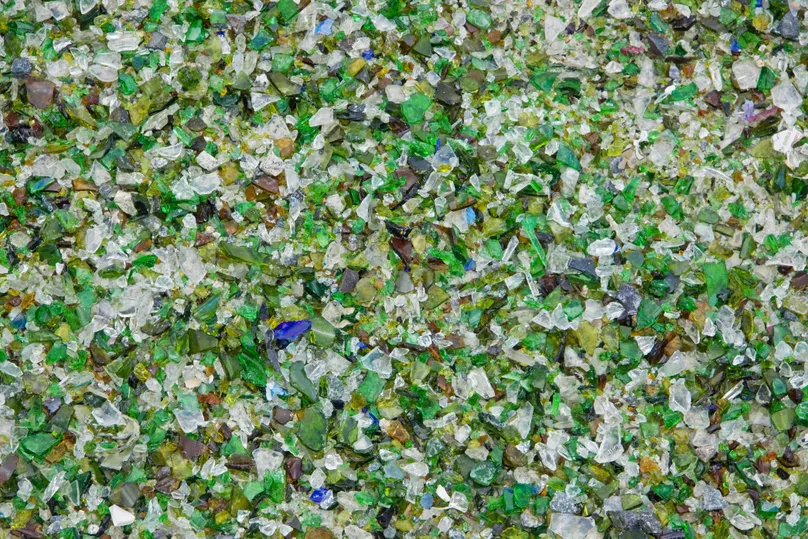Recycled glass
Recycled glass is produced from both industrial and consumer mixed glass waste that is not suitable for being recycled back into glass. The waste glass is processed and crushed into various materials including crushed glass (i.e., cullet), and sand (maximum size of 4.75 mm).
How is it processed?
Typically, this waste glass is sourced from municipal kerbside recycling and transferred to processing plants for separation. Some facilities have an additional sorting process to separate green, amber and flint coloured glass streams. Contaminants such as plastics, metals, organics and paper are removed. The recycled glass is crushed to satisfy the required particle size distribution and cleaned to eliminate undesirable odours.
There are 2 material recycling facilities in Perth that recycle co-mingled glass waste.
Environmental, health, and safety
Recycled glass may contain contaminants introduced during its use and disposal. State road agencies specify acceptable contaminant limits.
Austroads ATS 3050 specify the compliance requirements (gradation, concentration of chemicals and heavy metals and particles < 75 μm). High levels of contamination may cause environmental harm, contaminate groundwater or cause adverse health effects. Although, environmental impacts of heavy metal leachate are within permissible limits.
Recycled glass with particles ≤ 2.5 µm may become airborne if not handled suitably, appropriate personal protective equipment should be used. Studies have shown that recycled glass contains predominately amorphous silica and is therefore generally safer than products containing primarily crystalline silica.
Applications
Recycled glass can be used in a number of infrastructure applications. These include:
- bedding and embedment material for drainage piping and combined service route
- unbound granular materials
- asphalt
- road infrastructure (including glass beads, drainage blanket)
- washed sand replacement
- concrete
Specifications
Main Roads Western Australia currently has specifications for the use of recycled glass in Specification 302 for Earthworks. The main requirement include:
- grading (100% passing the 9.5 mm sieve)
- debris (plastic, rubber, metal etc.) <5%
- particle shape (< 1% of particles > 4.75 mm with an aspect ratio of > 5:1)
- clean to ensure undesirable odours are eliminated
The Public Transport Authority 8880-450-074: Specification - Earthworks, Slope Stability, Geotextiles and Erosion Protection aligns with Specification 302 for the use of recycled glass in embankment and backfill.
Benefits and challenges
Internationally, recycled glass has been used as an aggregate replacement for over three decades, reducing the dependency on natural aggregate resources and amount going to landfill.
Recycled glass at concentrations up to about 15% or more have shown no detrimental effects on performance in granular road pavement applications. Although, it is not recommended in cemented treated material due to the alkali-silica reaction which can lead to swelling of the glass particles and cracking
Asphalt mixes with recycled glass have been reported to be more susceptible to water-induced stripping due to poor adhesion between bitumen and glass particles. Although addition of hydrated lime minimises the stripping effects.
Moreover, poor skid resistance has been reported where recycled glass has been used as an asphalt surfacing layer. Use of recycled glass < 5 mm can mitigate these issues. In 2022, Brimbank City Council in Melbourne's west, in collaboration with NTRO, successfully trialled the use of recycled glass in asphalt on two residential streets. This was the first project in Australia to incorporate up to 10% recycled glass in wearing course asphalt, and the results of the trial have been successful.
Previous use in Western Australia
The NorthLink 3 Project used approximately 70,000 tonnes of recycled glass as embankment fill.

References
- Main Roads Western Australia (MRWA) 2024, Earthworks, Specification 302, WA.
- Brimbank City Council 2023, Brimbank works towards 100% recycled roads, viewed 4 October 2024, <https://www.brimbank.vic.gov.au/media-release/media-release-brimbank-works-towards-100-recycled-roads>.
- ecologiQ, Use of recycled glass in road and rail infrastructure, viewed 4 October 2024, <https://bigbuild.vic.gov.au/__data/assets/pdf_file/0011/739847/ecologiQ-Recycled-Crushed-Glass-Technical-Note.pdf>.
- Austroads 2023, Supply of Recycled Crushed Glass Sand, Austroads Technical Specification ATS 3050.